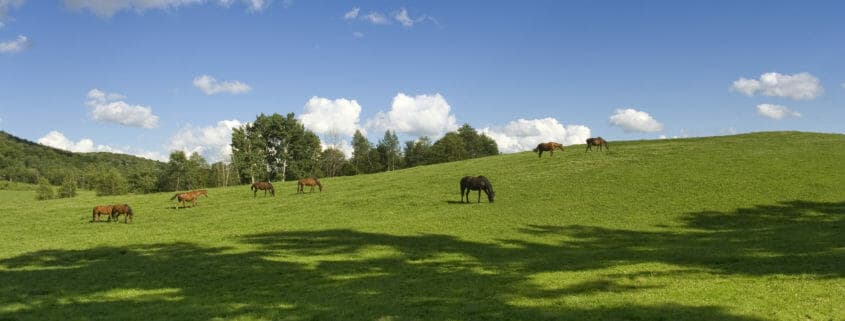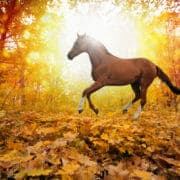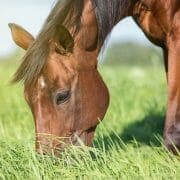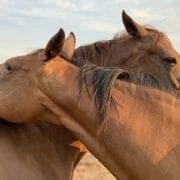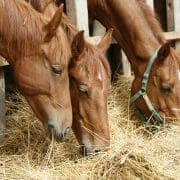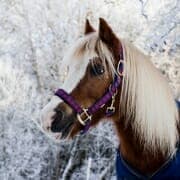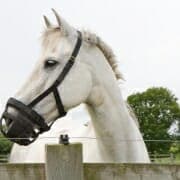Identifying Pastures: Part 1
Part 1: Identifying Ryegrass and Tall Fescue in your horse’s pasture
Pasture is an ideal feed base for any horse’s diet. It is an economical feed ingredient that provides an excellent source of energy, protein, vitamins and some minerals. Added to this is the benefit of the physical and mental stimulation grazing provides. Horses are born to graze.
However, some pastures can cause serious problems for horses. In Part 1 of this series, we will look at pasture plants that can cause endophyte toxicity. The two most common pasture species that can lead to endophyte toxicity are ryegrass and tall fescue.
The problem with endophyte pastures
Some species of ryegrass and tall fescue are inoculated deliberately or infected with wild endophyte fungi. The fungi then live within the plant in a symbiotic relationship where the plant provides the fungi with food and a place to live and the fungi provide the plant with protection from insect and nematode attack by producing mycotoxins.
So while the endophyte infected pastures are desirable from a pasture production perspective, the toxins they can contain can cause health problems for your horses. Horses grazing these pastures may exhibit some or all of the following symptoms (caused by the lolitrem B and ergovaline neurotoxins):
- Reduced appetite
- Weight loss or reduced growth rates
- Inability to correctly regulate body temperature
- Diarrhoea
- Excitable, unpredictable, irritable or uncharacteristic behaviour
- Over-reaction to common stimulus they would normally be OK with
- Muscle twitching or twitching of the face, lips and eyelids
- Prolonged gestation periods and thickened or retained placenta
- Aborted or small, ‘undercooked’ foals
- Dramatically reduced milk production in mares in early lactation
- Loss of coordination, especially in the hind end, and staggering
- Severe lameness
- Bleached and/or rough coat
These possible symptoms are obviously very broad and many of them can be caused by any number of other factors, so you need to be very, very careful not to jump to conclusions and assume that the problems you are seeing in your horses are being caused by your pasture.
If you are observing these symptoms in your horses, the first step to knowing if they are caused by the pasture is to identify the pasture plants in your pasture sward to see if ryegrass and/or tall fescue are present. If these grasses are not present, you need to look for other causes of the problems you are seeing.
Identifying grasses
First a bit about plant physiology; there are 4 parts of the plant you can use to identify the species in your pasture:
- seed head
- leaf
- auricle
- ligule
Seed head
The easiest way to identify certain plants is by finding their seed heads as grasses tend to have distinctive seed heads. Seed heads can either be in the form of a panicle, spike or receme (see below).
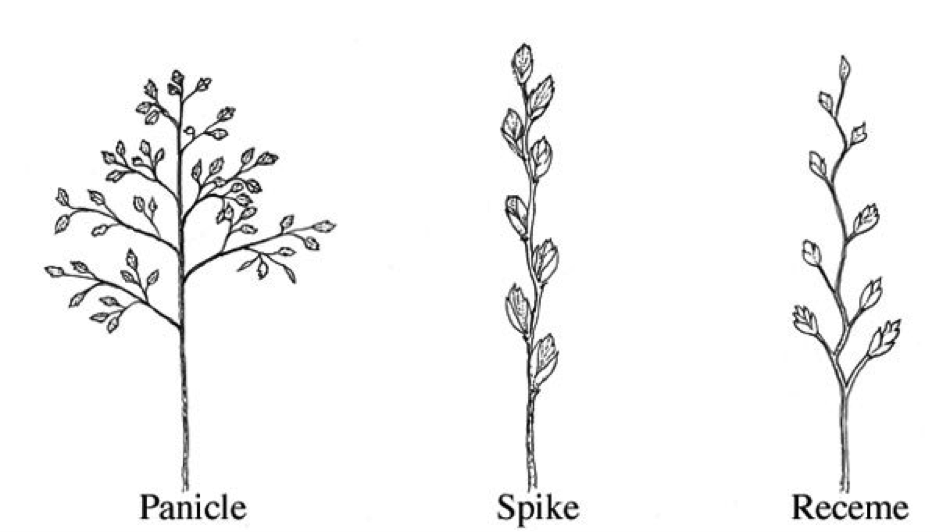
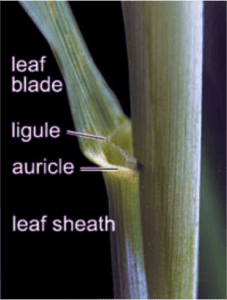
However, more often than not you will be trying to identify grasses that don’t have seed heads, so you need to use the physiology of their leaves and stem to tell them apart.
If seed heads are not present, you will need to use the structure of the leaf, auricle and ligule to identify your plants. These areas of the plant are shown in the photograph here.
The leaves
The first thing to look at with leaves is how the very youngest leaves are packaged within the shoot (called their ‘vernation’). Leaves can either be folded, appearing V-shaped in the shoot or rolled and appearing rolled in the shoot. The diagram shows both structures.
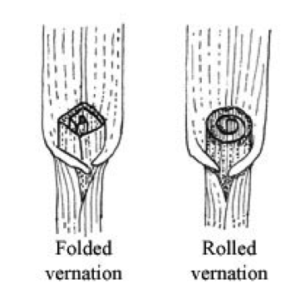
Next you should look at the leaf blades themselves. The blades can have one of a number of different ‘patterns’ in the veins. Some have one very dominant vein running down the centre of the leaf (Figure a below), others will have many equal sized veins (Figure b below). Others still have a dominant vein as well as smaller veins running in parallel. You also need to take note of how glossy or dull a leaf blade is and whether it has hairs on its upper and lower surface or not. Finally you should look at the tip of the leaf blade to see if it is ‘keeled’ or ‘flat and pointed’.
The diagram below shows some possible vein configurations and a keeled or flat and pointed leaf tip.

Ligules and auricles
Ligules are located at the junction of the leaf blade and leaf sheath (see photo above) and can either be membranous (something like opaque cling-wrap), hairy structures or simply absent. Auricles are extensions of the collar that is also located at the junction of the leaf blade and leaf sheath. Auricles can either be long and clasping, small and rudimentary or absent. The various ligule and auricle structures can be seen below.
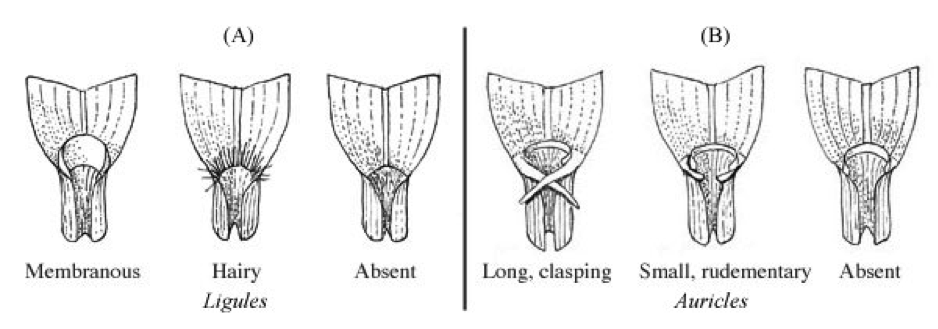
Growth habit
The final piece of the puzzle is to look at how the plant actually grows. Does it grow in a clump or bunch? Does it send out underground runners called rhizomes to establish new plants or does it use above ground stolons to establish new plants. These 3 growth habits are shown below.
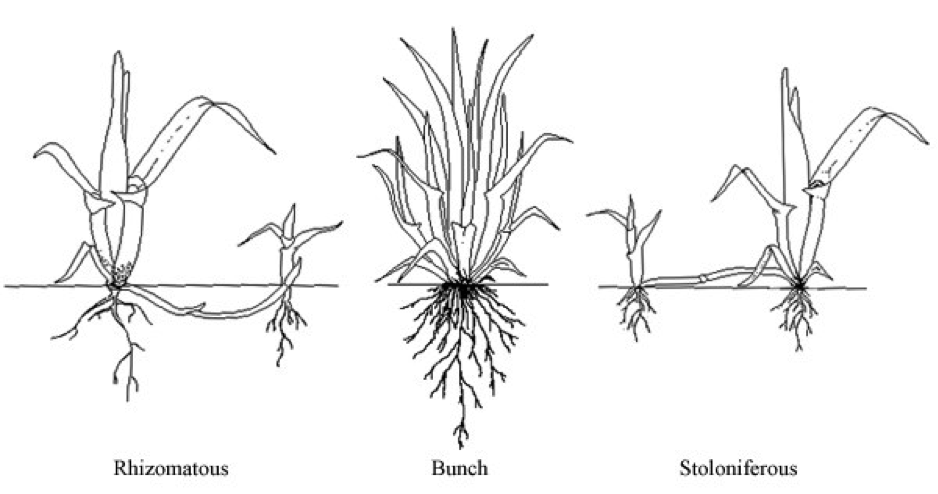
Identifying your grasses
OK, crash course in identifying pasture plants is over; it is time for you to look at some grasses. If you suspect you may have problems associated with ryegrass or tall fescue toxicity, take this Newsletter out into your pastures and see if any of the following grass profiles fit any of your grasses.
Perennial ryegrass
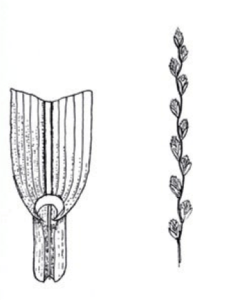
The characteristics of Perennial Ryegrass are as follows:
- Spike type seed head
- Emerging leaves are folded
- Leaves have a prominent mid vein with many smaller veins running in parallel
- Leaf is glossy underneath
- Leaf tip is keeled
- Auricles are small and may be absent all together
- Ligules are short and membranous
- Grows in a bunch growth habit
Annual ryegrass
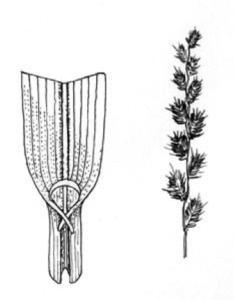
The characteristics of Annual Ryegrass are as follows:
- Spike type seed head but tends to be flatter and wider than perennial ryegrass spikes
- Emerging leaves are rolled
- Leaves have a prominent mid vein with many smaller veins running in parallel
- Leaf is glossy underneath
- Leaf tip is keeled
- Auricles are long and clasping
- Ligules are short and membranous
- Grows in a bunch growth habit
Tall fescue
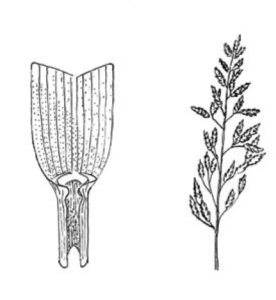
The characteristics of Tall Fescue are as follows:
- Panicle type seed head
- Emerging leaves are rolled
- Leaves many deep veins running in parallel with no dominant mid vein
- Leaf tends to be shiny underneath
- Leaf tip is pointed
- Auricles are absent
- Ligules are short and membranous
- Grows in a bunch growth habit
If you think you have these pastures but aren’t 100% sure, pot some of the plants you suspect are ryegrass or tall fescue and let them grow and go to seed. The seed head will help you to positively identify the species.
So you have these grasses … what now?
If you have accurately identified that ryegrass and/or tall fescue are present in your pasture, this doesn’t necessarily mean that they are causing problems you may be observing as there are endophyte free varieties of both of these grasses and even endophyte infected grasses don’t always have levels of mycotoxin capable of causing issues, so you can’t jump to conclusions.
One way to check if these grasses are causing your problems is to remove your horse completely from the pasture for 5 to 7 days and watch for signs of improvement. If the problems you were seeing go away or improve, and if putting your horse back out on pasture sees them return then it is possible they are the source of your problems.
You can have your pastures tested for lolitrem B and ergovaline levels to confirm the presence of these toxins in your pasture sward. For details of laboratories who can run these analyses please email us at help@feedxl.com.
Managing Ryegrass and Tall Fescue Toxicity
The purpose of this newsletter was to give you the information you need to identify these potentially problem grasses. Managing the toxicity caused by these pastures is too complex a topic to be covered in a short space here without doing it an injustice. Another newsletter will be written covering this topic in detail. In the meantime, if you need help, please go to the FeedXL Member Forums.
Some more useful references and acknowledgements
Diagrams and photos are from Penn State College of Agricultural Sciences and the Food And Agriculture Organisation. There are some useful photos of the leaves and seed heads of perennial ryegrass and tall fescue at https://www.massey.ac.nz/about/colleges-schools-and-institutes/college-of-sciences/our-research/themes-and-research-strengths/plant-science-research/pasture-plant-identification/
Do you have a question or comment? Do you need help with feeding?
We would love to welcome you to our FeedXL Horse Nutrition Facebook Group. Ask questions and have them answered by PhD and Masters qualified equine nutritionists and spend time with like-minded horse owners. It’s free!
Click here to join the FeedXL Horse Nutrition Facebook Group

